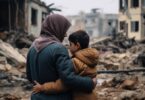Humanitarian aid refers to mostly short-term assistance in the form of materials (like medical supplies, food, water, etc) and logistic aid. It’s intended to provide help quickly in the aftermath of various crises (floods, conflict, disease outbreaks) until the government and other organizations can develop long-term plans. The goal is to save lives, relieve suffering, and protect human dignity. Meeting these goals is expensive but necessary. Using data from sources like UNICEF’s Global Annual Results Report 2020 as a guide, we can identify 15 key reasons why humanitarian aid is so important:
#1. Hundreds of millions need humanitarian aid
According to a 2021 United Nations report, an estimated 274 million people will need humanitarian aid in 2022. This represents a year-over-year increase of 17%. The report gives more reasons for the higher number, such as a rise in extreme poverty. 43 countries (and 45 million people) are also at risk of famine. To meet this record need, it will take $41 billion, a budget experts like Martin Griffiths, UN Humanitarian Affairs chief, are doubtful about receiving. Humanitarians will do what they can with the funds they get. Last year, even in the face of extreme need due to COVID, the humanitarian system was able to reach 70% of its target. While aid doesn’t fix the causes of a crisis, it undeniably lives and relieves suffering.
#2. Aid saves millions
Saving lives is the main goal of humanitarian aid. When food, water, medical supplies, and other resources are mobilized, human lives are saved from dangers like disease, hunger, thirst, and exposure to the elements. Let’s look at UNICEF as an example. In 2020, 4 million children with severe acute malnutrition were admitted to treatment programs. Without these programs, these kids would likely have died. 17 million kids (age 6 months-15 years) were vaccinated against measles, a disease that killed over 200,000 people in 2019. Without programs targeting issues like hunger and disease, death counts would be higher.
#3. Aid is needed quickly in emergencies
Humanitarian aid is essential during crises like droughts, natural disasters, or conflicts. With very quick turnarounds, organizations mobilize huge amounts of resources and deploy wherever they’re needed. As an example, the United Nations Disaster Assessment and Coordination (UNDAC) can deploy within 12-48 hours anywhere in the world. Their role is to help during the first phase of an emergency and assist in coordinating incoming international relief. Governments move much slower, so emergency aid is needed as a stop-gap measure.
#4. Aid meets nutritional needs
Food is one of the most important concerns during crises. Without proper nutrition, people are at risk for a host of health problems, as well as death. Organizations like the World Food Programme focus on meeting nutritional needs. It’s the largest humanitarian organization providing school meals to children. In 2020, WFP provided 15 million children with school meals. With UNICEF, WFP also supports governments in adopting an integrated approach to children’s nutrition and health, which includes school meal programs.
#5. Aid addresses water and sanitation issues
WASH (which stands for water, sanitation, and hygiene) is a major focus for many humanitarian groups. Without access to clean drinking water and sanitation, people face the risk of waterborne disease, dehydration, and other problems. A variety of crises can threaten WASH, including natural and man-made disasters. Humanitarian organizations mobilize to build proper systems (like garbage and waste disposal), hand out clean water, and provide education on WASH.
#6. Aid meets health needs
Humanitarian efforts include medical and mental health projects. In just about any crisis, health is a primary concern. Some crises are specifically health crises, like disease outbreaks. Aid consists of things like medical supplies and medical professionals who can deliver services like vaccinations. The COVID-19 pandemic is a prime example of the need for medical humanitarian aid. Vaccinations, supplies, personal protective equipment, and medical personnel are all needed.
#7. Aid addresses a lack of shelter
According to the UNHCR, shelter is “a vital survival mechanism in times of crisis or displacement.” It’s essential to “restoring personal security, self-sufficiency and dignity.” Providing shelter during crises can be complicated. In urban areas, refugees often have to live in public buildings and other informal settlements where conditions can be poor. Shelter concerns include shelter materials, technical support, rental support, cash assistance, safety, privacy, and more. Without proper shelter, it’s very difficult for a community to regroup and rebuild.
#8. Aid protects education for children
Crises disrupt education for children and deprive them of schools, which are a shelter from abuse and exploitation. School is also where many children receive essential services like food, clean water, healthcare, and hygiene. Schools are also a source of psychosocial support, which children will need more of during emergencies. Humanitarian aid should include education, although currently, the education sector gets less than 3% of aid. There are other complications like staff shortages and coordination issues. Organizations like UNICEF work to protect education for children by creating safe learning spaces, training teachers, and supplying materials.
#9. Aid helps communities recover and rebuild
Humanitarian aid addresses emergency needs, but it can also play an important role in communities recovering and rebuilding. This approach, known as “Early Recovery,” is a multidimensional process that begins alongside addressing emergency needs. It focuses on building resilience, strengthening capacity, and contributing to fixing long-standing problems. Local ownership is prioritized, so communities can quickly become self-sustaining. Humanitarian organizations help in this process through various methods, including cash distributions, micro-finances, and livelihood development programs. Humanitarian aid is different from development aid, but in early recovery, humanitarian aid serves as a bridge to longer-term development.
#10. Aid helps communities prepare for crises
Disaster preparedness is part of humanitarian aid. As an example, for five years, 56% of all EU-funded humanitarian projects included a disaster preparedness component. These measures, which include governments, organizations, communities, and individuals, help areas better prepare and respond to disasters. Things like early warning systems, contingency plans, and stockpiling supplies and equipment can save lives, mitigate the effects of crises, and increase community resilience. This makes disaster preparedness a very cost-effective decision that helps aid organizations save more money.
#11. Climate change is a major humanitarian crisis
According to NOAA, the impacts of climate change on food and water are significant and interconnected. Drought harms food production and human health. Flooding spreads disease and damages infrastructure and ecosystems. Existing socio-economic inequities put marginalized groups at an increased risk. According to many experts, climate change is the worst threat humans currently face. This challenges the effectiveness of humanitarian aid, which is already unable to meet the needs of populations around the world. For years to come, humanitarian aid will need more funding to address the effects of climate change.
#12. Women and girls are affected differently by crises
Crises like drought, flooding, and conflict affect everyone, but certain groups are more vulnerable. Women and girls face more risks during displacement and when protective structures and support dissolve. They often handle risky responsibilities, as well, such as caring for people who are sick. In some crisis settings, more than 70% of women experience gender-based violence. COVID-19 worsened gender equality, as well. The global gender poverty gap for women aged 25-34 is expected to increase from 118 women for every 100 men in 2021 to 121 women in 2030. According to the World Economic Forum, COVID-19 added another 100 years to the journey toward gender parity. Many humanitarian organizations prioritize the most vulnerable girls and women to ensure they get the support and resources they need.
#13. Aid protects children and mothers
Like girls and women, children and mothers face unique risks during crises. In 2017, around 295,000 women died during and following pregnancy and childbirth. 94% took place in low-resource settings. Most could have been prevented. Factors like poverty, travel distance to facilities, and poor-quality services contribute to maternal mortality. Groups like UNICEF coordinate initiatives and campaigns targeting the specific needs of moms and kids. In 2020, over 500,000 children and pregnant/lactating women received health services and education. In Yemen, more than 260,000 children under 5 received treatment for severe acute malnutrition. In South Sudan, UNICEF worked with partners to provide 1.9 million pregnant and lactating women with counseling on infant and young child feeding.
#14. Aid is needed to deal with the long-term effects of COVID
The COVID-19 pandemic ravaged the world, reversing positive trends in extreme poverty, gender equality, and more. By the end of 2020, 270 million people were facing acute food insecurity. This represents an 82% increase since COVID started. The humanitarian world mobilized in a way it never has before, but the road to recovery is long and hard. If the world hopes to recover and rebuild from the pandemic, humanitarian aid (as well as government support) is needed now more than ever.
#15. Aid protects human rights (but needs to be anti-racist and equitable)
All human rights matter, but humanitarian aid protects what most people consider the most essential: life, water, food, sanitation, shelter, safety, and education. Governments are primarily responsible for providing and protecting these rights – especially after a crisis – but for one reason or another, many are unable or unwilling to. Humanitarian aid steps in to fill the void. Because of their responsibility, humanitarian organizations must be held to a high standard. That means reckoning with the history of aid and colonialism. In “Race, equity, and neo-colonial legacies: identifying paths forward for principled humanitarian action,” Saman Rejali writes: “In order to create more equitable and anti-racist institutions, the humanitarian sector must first acknowledge the role neo-colonial legacies continue to play in humanitarian assistance and protection activities and within humanitarian organizations, which are most at need of equity-driven systemic changes.”












